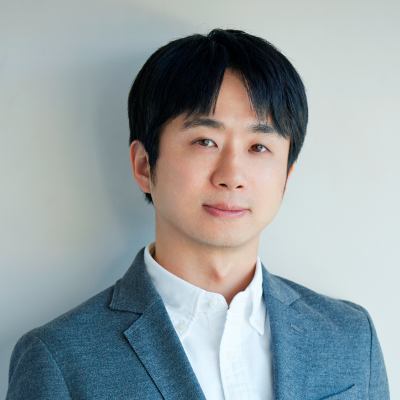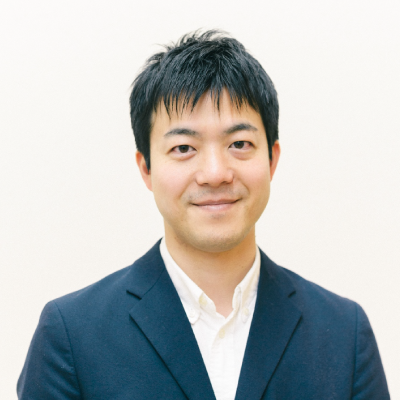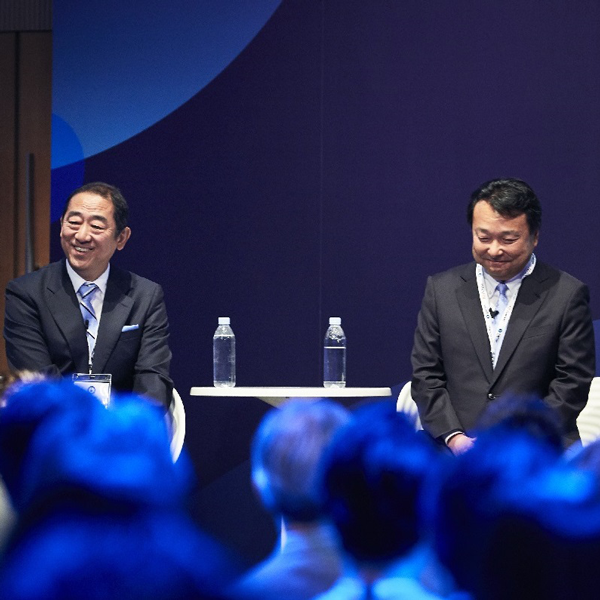- Events
Hakuhodo DY Group seminars at Advertising Week Asia 2018:
What is ad creation? Redefining our expertise and fields of activity
Advertising Week Asia was held this year for the third time at Tokyo Midtown in Roppongi, Tokyo from May 14–17, 2018. Bringing together a total of 13,000 people across four days, the event’s seminars were very well attended. The following is a report on a session given by Shoo Okada of Hakuhodo’s Brand & Innovation Design Division and Satoshi Umeda of Dentsu for young people in the ad industry on the distinguishing qualities of advertising as a job.
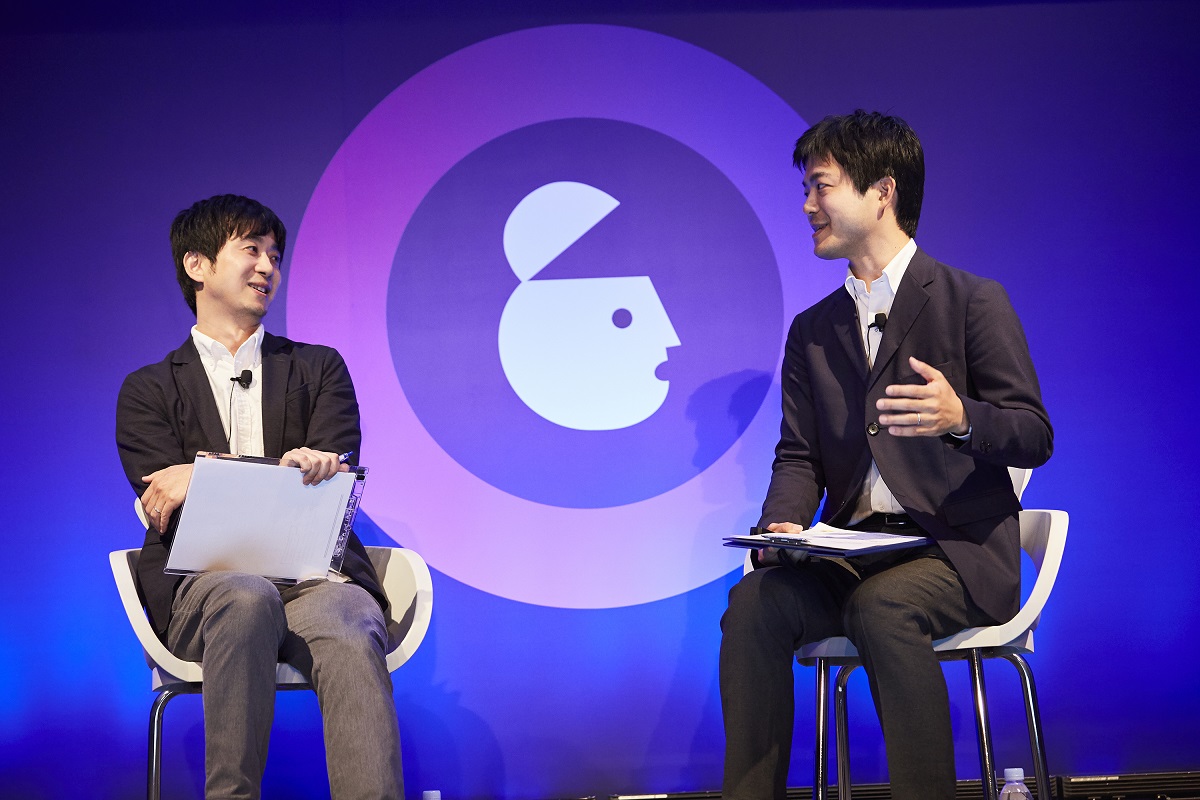 Satoshi Umeda, Holistic Solutions Division 1, Dentsu (left) and Shoo Okada, Brand & Innovation Design Division, Hakuhodo (right)
Satoshi Umeda, Holistic Solutions Division 1, Dentsu (left) and Shoo Okada, Brand & Innovation Design Division, Hakuhodo (right)Redefine things in terms of contemporariness to generate new value
OKADA: Something abnormal is going on in the advertising domain these days. In a sense, it’s got too broad. So what does the ad industry, and ad people, consider their No. 1 expertise? I’d like to go back to basics a bit for our young, up-and-comers. To briefly introduce myself, I am normally involved in branding and innovation consulting work, and CI work for clients at Hakuhodo. My partner today is Satoshi Umeda from Dentsu, who is the same generation as me.
UMEDA: My name is Umeda. I’m a creative director working in Integrated Solutions Division 1, a division not only involved in creative, but also in creating integrated solutions that incorporate marketing, creative and media overall.
When I met with Mr. Okada about this session, I discovered several commonalities between us, one of which is that we’re both from the generation that is neither newbies nor supervising others. You could probably think of us as elder brothers you can count on. We’d like to be guys rookies look at when they’ve got problems in the job and say “If we’ve got guys like this around us, let’s give it our all.” Because the reality is there are no role models in the ad industry these days. So we’d be happy if you thought of us not as role models, but as guys to get ahead of.
OKADA: And both of us look like the sort that will quit, but we don’t [laughs]. When you publish books and give presentations, there are a lot of opportunities for your name to get out there and sometimes people look at you like you will be leaving the company any day now [laughs]. But we won’t be quitting. Mr. Umeda, there’s a reason you won’t quit, right?
UMEDA: You got it. To begin with, when you think about the core of what we do, and how we can leverage that core going forward, there are lots of reasons to stay with the company. Today, I’d like to talk about what makes that core, and how to expand it and push it beyond the limits.
OKADA: First off, we’d like to show you one image each about the title of today’s seminar, “What is ad creation?” Mr. Umeda, what is this?
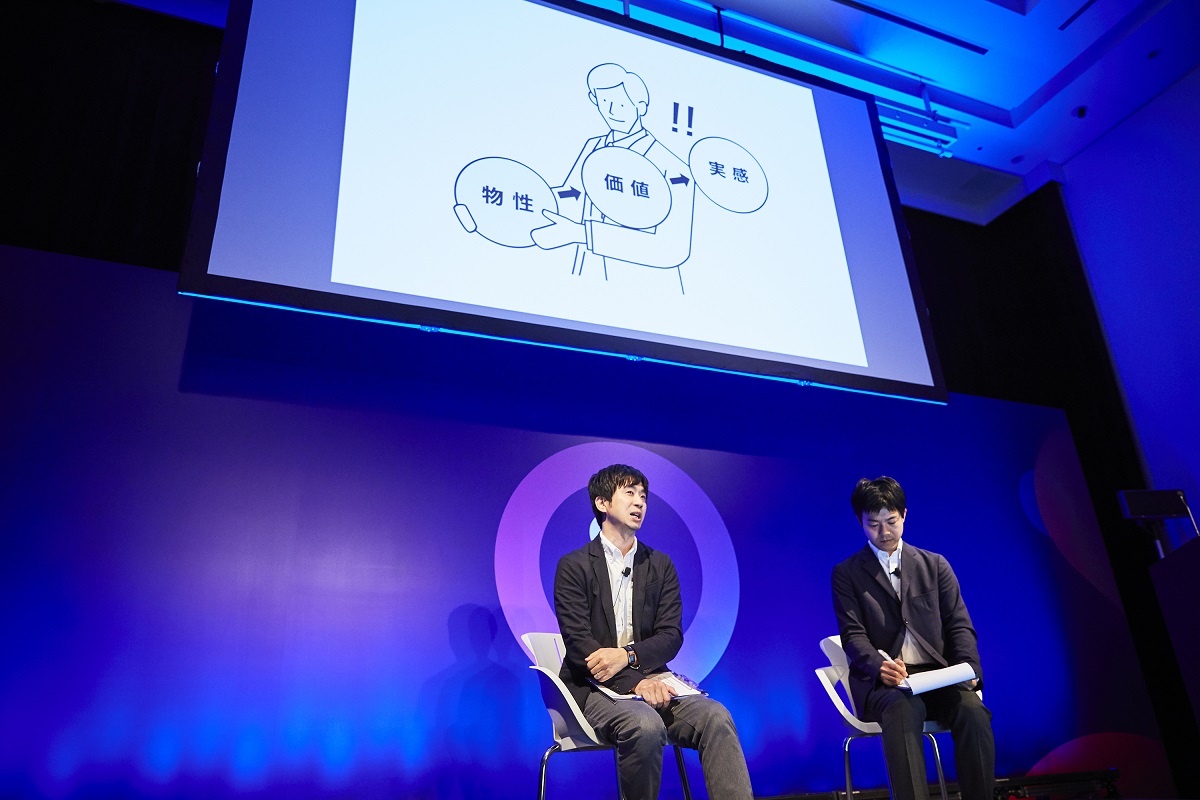
UMEDA: This diagram shows the relationship between users and a brand. Making people aware of something and clearly conveying what’s good about it, that’s the real root of ad creation. This is the material thing, if you will. We think about how to spread this material thing. But if you take a step back to look at the big picture, you can see that the product or service, that is the brand, doesn’t exist in isolation. It is critical to always look at the relationships, such as between people and the brand and people and the product or service. When this cold material thing gets into people’s hands, it is transformed into something warm by way of the value it provides as something new, something changed. Creating this context is the value of advertising, I think.
It was a job I did in 2009 for diapers that made me realize this. As someone who doesn’t have kids, during the planning all I could come up with at first was “odor-eating” and “doesn’t leak.” In other words talking about physical properties. Wondering what I needed to do to say more about them than that, I stayed at the place of a friend who’d just had a baby, like a lodger who doesn’t pay room and board. For about a week.
OKADA: Really! [Laughs] So you basically did an observational study.
UMEDA: It was marketing on the ground. I was a huge pest [laughs].
And you can’t beat being there on the spot. The idealized scenes of calm and smiling parents and babies playing hide and seek doesn’t exist in the world anywhere. What is there is the exhaustion of heroic mothers and their determination to look after their kids. So I realized that making claims from on high about product features is not a real help in these circumstances.
I thought about the value that needs to be there when this mother picks up the product. This led me to the idea of being on the mother’s side, or more specifically, planning that didn’t skirt around how hard raising a child is.
At that point, the 1963 lullaby Konnichi wa akachan popped into my head. The song is filled with the joy and euphoria felt at the moment a child is born. It might be overstating it a bit, but ads up until now have not been able to leave that world behind. The key was to have that happiness as the base, but include the worries and troubles of mothers today. In other words, to create a Konnichi wa akachan for today that would give mothers struggling with the daily grind of raising a child a boost by telling them that they’re doing okay. Could we not perhaps have creative that keeps the intrinsic qualities of love between a mother and her child and infuses it with an air of the times and contemporariness? This gave birth to the tune Hoshi no kazu dake (Just as many as the stars). I composed and wrote the lyrics myself. This gave the commercial a real sense of “I thought it would be so happy, but the tough days just kept coming, but I was saved.”
OKADA: Instead of the materiality of the diapers, you redefined the value of childrearing for the times and cheered mothers up. I think the term contemporariness is an important key word when you think about advertising as a job.
UMEDA: Right. Intrinsic qualities and attributes are easily polarized. Intrinsic qualities are the core of a thing, while attributes change. This leads to the misunderstanding that intrinsic qualities don’t change. But in reality, intrinsic qualities can change, too, like the realities of raising kids in a given age. The necessary standpoint here is to look for the attributes of the intrinsic qualities. I always try to notice changes to the attributes of intrinsic qualities in order to redefine the intrinsic qualities.
OKADA: I, too, created a visual on the topic “What is ad creation?” Someone in manufacturing once said that if you follow manufacturing to its logical conclusion, it is nothing but creating a product, manufacturing it in large quantities, and selling it. If you apply this to advertising, you get this diagram. Originally, advertising began from “Spread using the media” on the far right. Starting with redefining a product’s value or, if you will, creating meaning—such as in the diaper example—that is the most intriguing thing about advertising, I think.
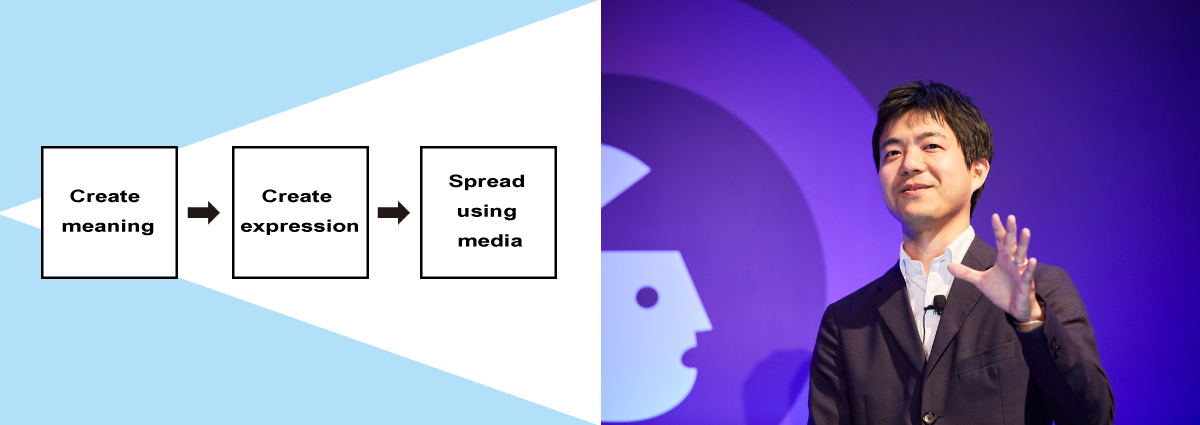
The reason I think this goes back three or four years to when I asked an older copywriter who was about to retire about the work that left an impression. The copywriter had created a whole slew of well-known ads, but he said, “Coining the term jukunen (mature-aged).” It’s a word we use without thinking these days, but can you imagine! Before that the elderly had a negative image. It made me think how amazing ad creation is as an occupation. If there are any rookies that don’t really feel much fascination for advertising as a job, it might be because they are stopping at the spreading and making work and are not involved in the creating bit, which is the most seductive.
Famous copy conceived by uncovering what the client’s passion is
OKADA: Next, we’d like to give you another diagram on what expertise we ad people have. You go first, Mr. Umeda.
UMEDA: What do you think this is? If I add color I think you’ll get it.
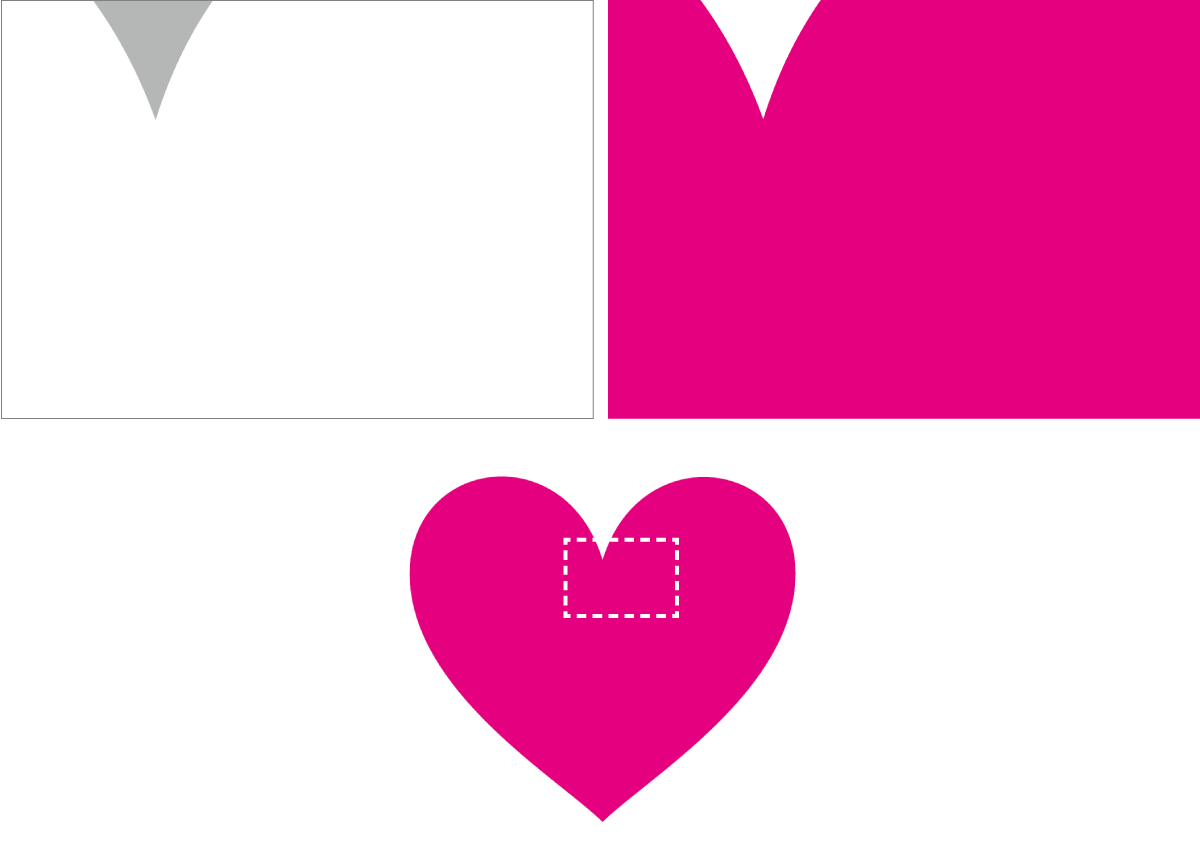
Let’s take a step back. Now do you get it?
Yep, it’s a heart. You feel cheated, don’t you? But this is the situation those of us with jobs in advertising face. We are given really detailed information on a localized point and asked to look at that point. Then, like the first image, you don’t have a clue about the big picture. When you are given super-localized and dense information, can you take a step back and question again what the job is really about. This is really important in our line of work. I call this process drawing auxiliary lines toward value.
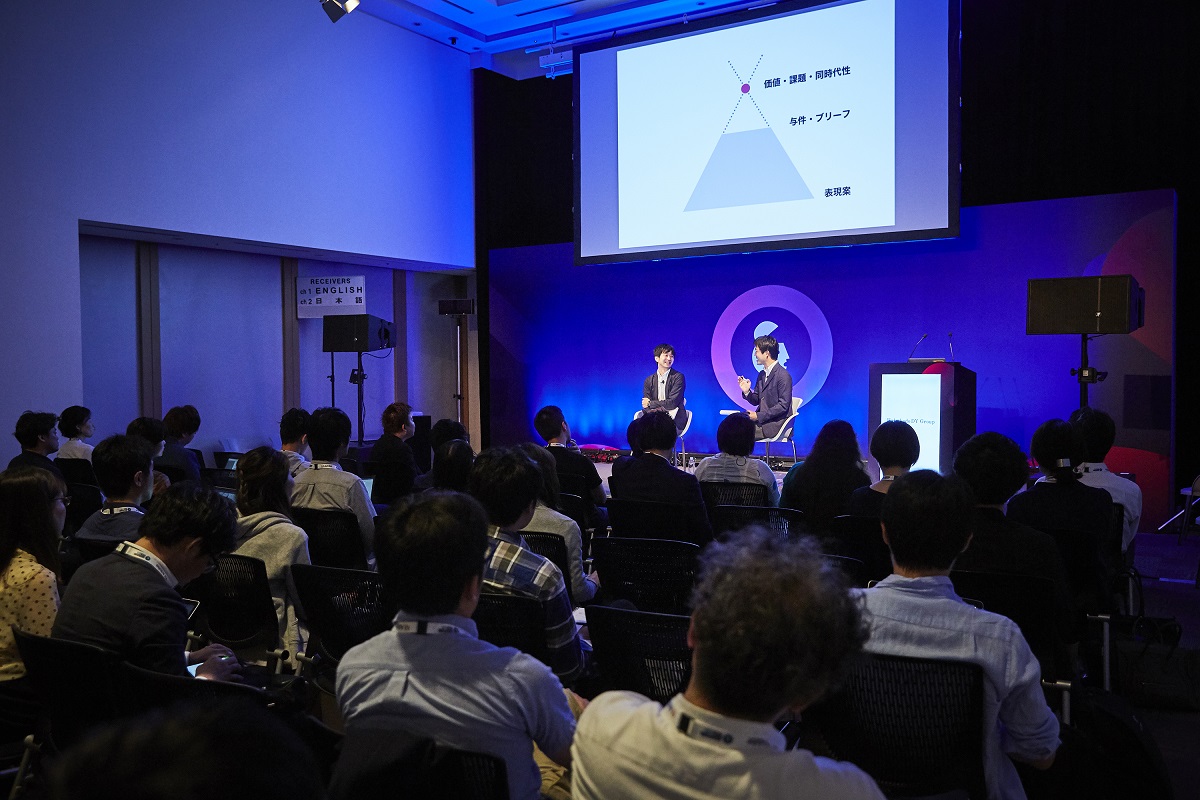
When we get exceptionally localized and high-res information, we need to be able to reduce the resolution and draw in auxiliary lines. For instance, say a new product is coming out. You will be told, “This has changed, and this, too. And this is superior to other brands. So, what sort of ads are you going to create?” If we look at this in terms of the heart diagram, this is at the level where you’re not sure if it’s a heart or not and the “look at this here” bias kicks in.
This is when a concrete idea pops into your head, right? You start thinking how about using this celebrity and that media, or maybe it would be better to go with VR… This thinking is already half-way to becoming clear expression, or to put it another way, toward becoming concrete.
But what you really need to do is redraw auxiliary lines going upwards, that is, to redefine the challenge and the concept. You need to go upwards, thinking about things like: Is there something more important? Does the client want to tell me something but doesn’t have the words? What are the reasons and processes behind what they’ve just said?
OKADA: Mr. Umeda wrote the copy “The world is made up of someone’s work” for Georgia canned coffee. If you liken what you just said to that, how did you come up with it?
UMEDA: Competition in the canned coffee market was growing fiercer. So trying to raise Georgia’s profile with “Now even tastier” or “This is different from before” claims—the story is likely to stay at the bottom of the arrow if you think about the diagram earlier.
But if you’re talking flavor, whether you can beat the competition with that is a whole different question. Creating a big movement from that, well that’s going to be pretty difficult. To find the real answer, you need to think about fundamental things, like why does canned coffee exist, and how come there are so many vending machines in Japan. Rather than expression, the concept and values at the top of the arrow, that’s where you’ll find the answer. Then you’ll see the value of canned coffee. You might even come up with a hypothesis that the tastiness of canned coffee is determined by the amount of effort you’ve put in up till you drink it. That in a sense, there’s a “foretaste,” and the flavor is decided by how hard the person has worked. It’s important to have this discussion as a team, including the client.
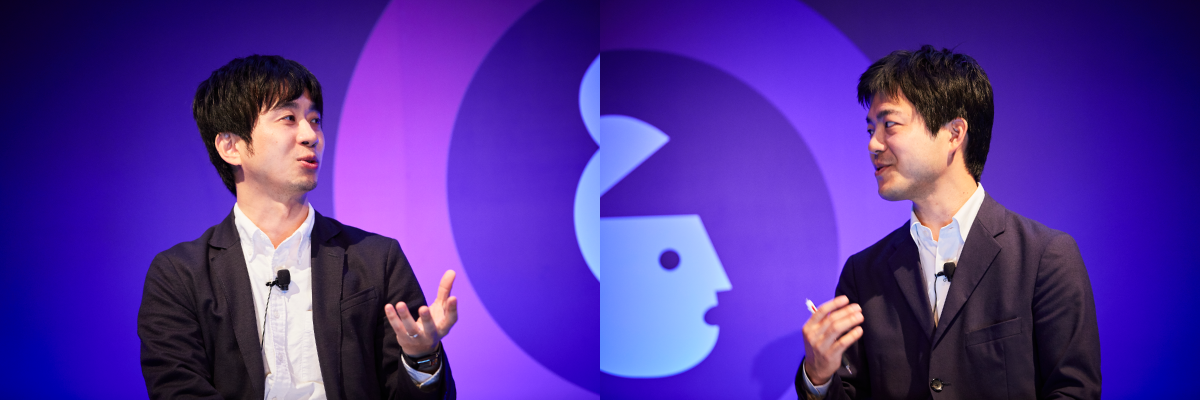
OKADA: So similar to how good a beer tastes at the end of the work day.
UMEDA: Exactly. Although you could say the same about a toast at work, too [laughs]. The “foretaste” is made up of the work each of you has put in. Then you talk about the canned coffee itself, and your mind might go on to think about what hard work is. And you arrive at the importance of expressing with a sense of solidarity the idea that your work is creating value in the world. So, contemporariness. And from there, the message “The world is made up of someone’s work” is born.
I pay close attention to as many voices within the client as I can to increase the abstractness of my thinking, not only for the work for Georgia. I ask what the manufacturing and frontline people are thinking when they create the product. Actually, the raison d’être for the product or the reason it was developed is often hidden there. So I ask them everything from what makes them proud of their work to their statement of purpose. Why they’ve thrown their lot in with the company. If you tease it out, surprisingly everyone has that, a reason why they have to do what they do. I think that uncovering that is our true expertise. Although asking people why they work where they do is, in a sense, pretty rude [laughs].
OKADA: Probably only an ad agency could ask such probing questions, don’t you think? Advertising a product is advertising passion for the product. So our expertise is our ability to bring that out.
I also created a visual on the subject of our expertise. When there’s water in a glass, some will say it’s half empty and some that it’s half full. Advertising’s expertise is saying it’s half full and if you drink it you can keep on running, or you can use it to make a beautiful flower bloom. I think our job is to put a positive spin on something that somebody thinks is only half full. It’s adding a new meaning that that person would never have thought of. To me, this is actually the most important facet of ad creation. Not creating deliverables, but changing the other party’s point of view; having someone say to me, “After talking to you, I think it’s great now.”
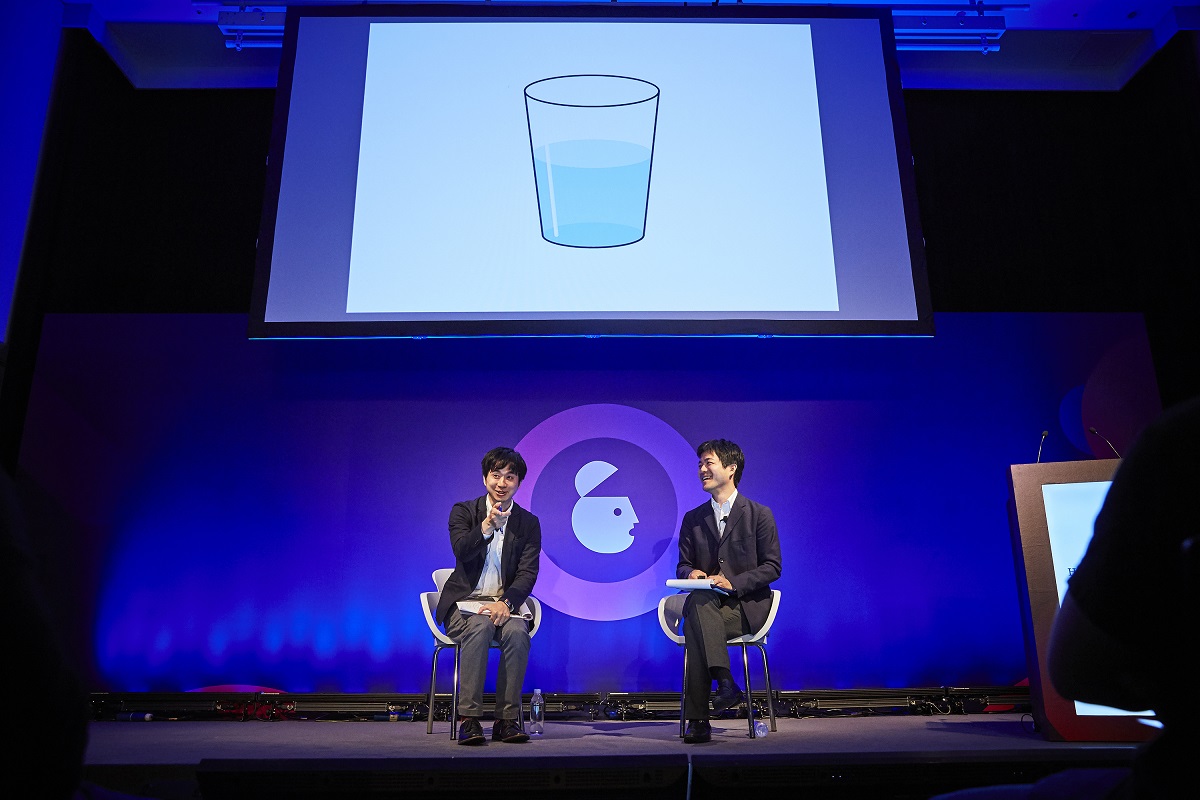
For that reason, I think that the client’s advertising division would have naturally been pleased with Mr. Umeda’s “The world is made up of someone’s work” copy, but even more than that, it would have given the people that deliver Georgia products to stores every day and those that sell them pride in the work that they do.
What will our future fields of activity be?
OKADA: Our final topic is what is going to happen to our fields of activity. You go first, Mr. Umeda.
UMEDA: I feel that the fields of activity we ad people will be involved in will go in two directions—the bleeding-edge and the frontlines. The bleeding-edge of advertising is digital marketing and augmented reality, which are represented by the pointy end at the bottom of the arrow in the diagram. Digital marketing is a hot topic here at Advertising Week Asia, too. On the other hand, the frontlines are the theaters of operation for all the fields of activity out there. Advertising thinking is yet to fully reach those frontlines. I think that’s where thinking about how we can put our knowledge to use, and whether we believe we can take advantage of it, will become crucial. Digital marketing is going to be a compulsory part of education in the industry. I, too, tussle with data and digital in my work. But on a more personal level, using the skills I’ve cultivated in advertising in other fields is more satisfying and exciting.
What’s important here is that you orient your thinking about problems to the client’s thinking. Advertising is transforming into a problem-solving business, but the definition of the problem still so often feels ambiguous. Is it a client problem or a social problem? In terms of expanding into the frontlines, overwhelmingly, it will be the latter that is important. What solutions can you come up with for problems within yourself? Can you make use of your skills? I plan to face each of these one by one and make them happen.
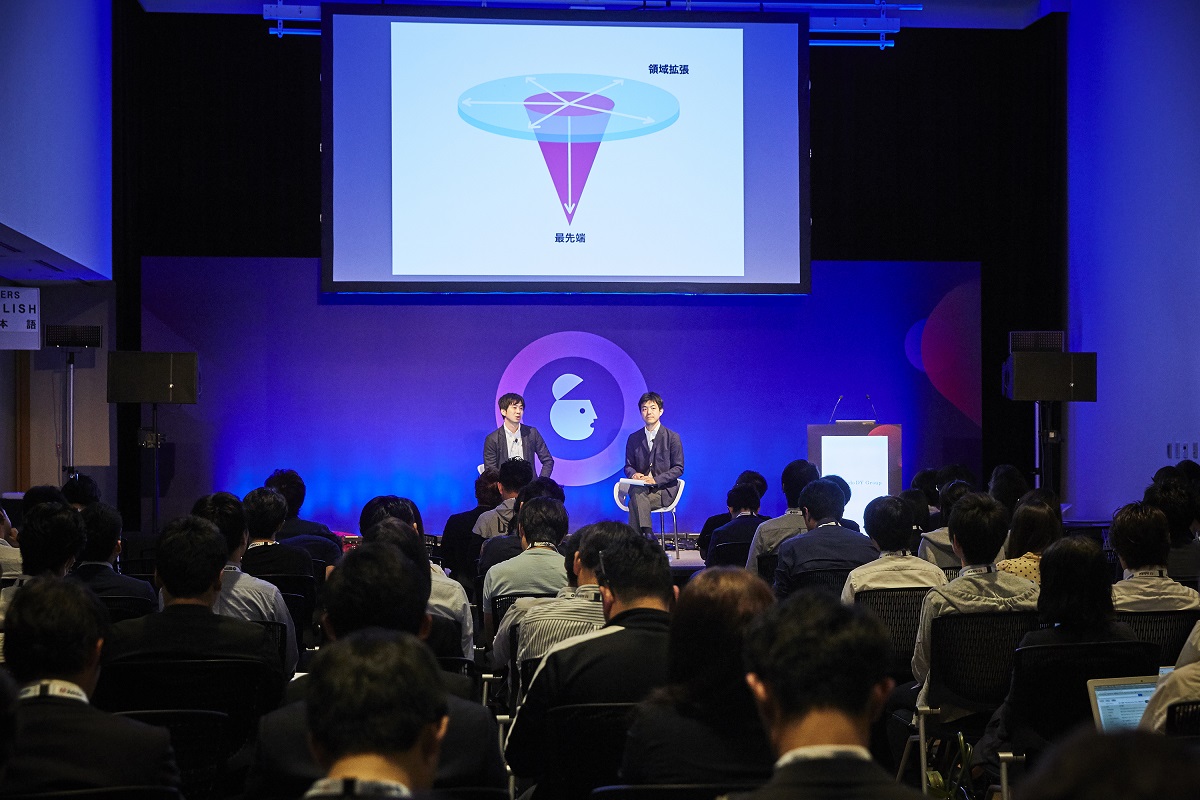
OKADA: So that’s what you were exploring with your book Suteneko ni hirowareta otoko (The man taken in by the abandoned cat) (Nikkei Publishing Inc.), right?
UMEDA: My family are cat foster parents and we live with a black cat called Daikichi. Being a cat foster parent, I realized that there’s this negative image about foster parenting, which creates a barrier for everyday people. So I wanted to make advertising about my own foster parenting activities. The foster parent system is not very approachable, and you often hear comments like, “If I’m going to live with a cat, why not just get a cute kitten from the pet shop?” So it’s about creating a new option. Which I thought advertising was the perfect method for.
Through my book, I am able to tackle this in line with my own awareness of the issues, but in my client work, too, there’s a moment when my perceptions of the problem and the client’s coincide. It’s something like serendipity. You are concentrating hard and unbidden by anyone, as you’re thinking about touchpoints with society, a solution presents itself from somewhere inside yourself. The air of the times is also reflected there, perhaps creating contemporariness in the output, too.
OKADA: I see. Here’s the picture I drew. It’s aikido. Like aikido, a sport where you cleverly use your opponent’s power against them, in the ad business, too, I think the other person’s passion is important. Who is the other person? It’s not people with money, but people who sense an impending crisis and think that something needs to change. They might be in the client’s advertising and PR departments, or sometimes they are somewhere totally different, but it’s important, I think, to first go and meet these people.
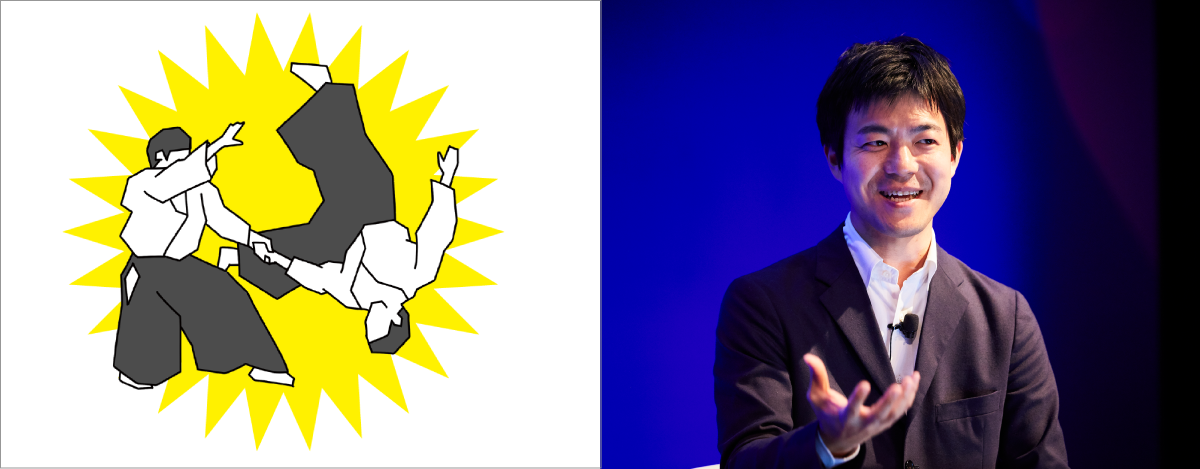
In Brand Tamago, a web column I am editor-in-chief of, we interview young guys giving their all in traditional industries that are becoming obsolete. The thing they share is a sense of crisis. An absolute sense of urgency that things are going to go to hell in a handbasket if something doesn’t change. There aren’t so many people like that in the world. I believe that if we don’t go out of our way to meet them, our expertise won’t be used and therefore we won’t be able to hone it. So if there’s someone like that in your job now, you should value that job. You should go out of the office to find them, proactively go and see your superiors, or your superiors’ superiors, or guys high up at a client, and tell them what you’re thinking and get feedback. This, I think, is how we will discover our future fields of activity.
Finally, I’d like to ask Mr. Umeda for a few words for the up-and-comers here today.
UMEDA: I’d say, “Young people, stand out more.” Don’t leave here for somewhere else, if you’ve got ability, use your talents to change your focus toward something else. The important thing there is to hone your weapons and have the will to take those weapons in hand and go and stand out. But even if you just want to do something, it ends up well, what can you do? If you can’t say, “I can do this and change this value to create a new solution,” you won’t be able to stand out. In fact, this standing out is what generates new business and innovations.
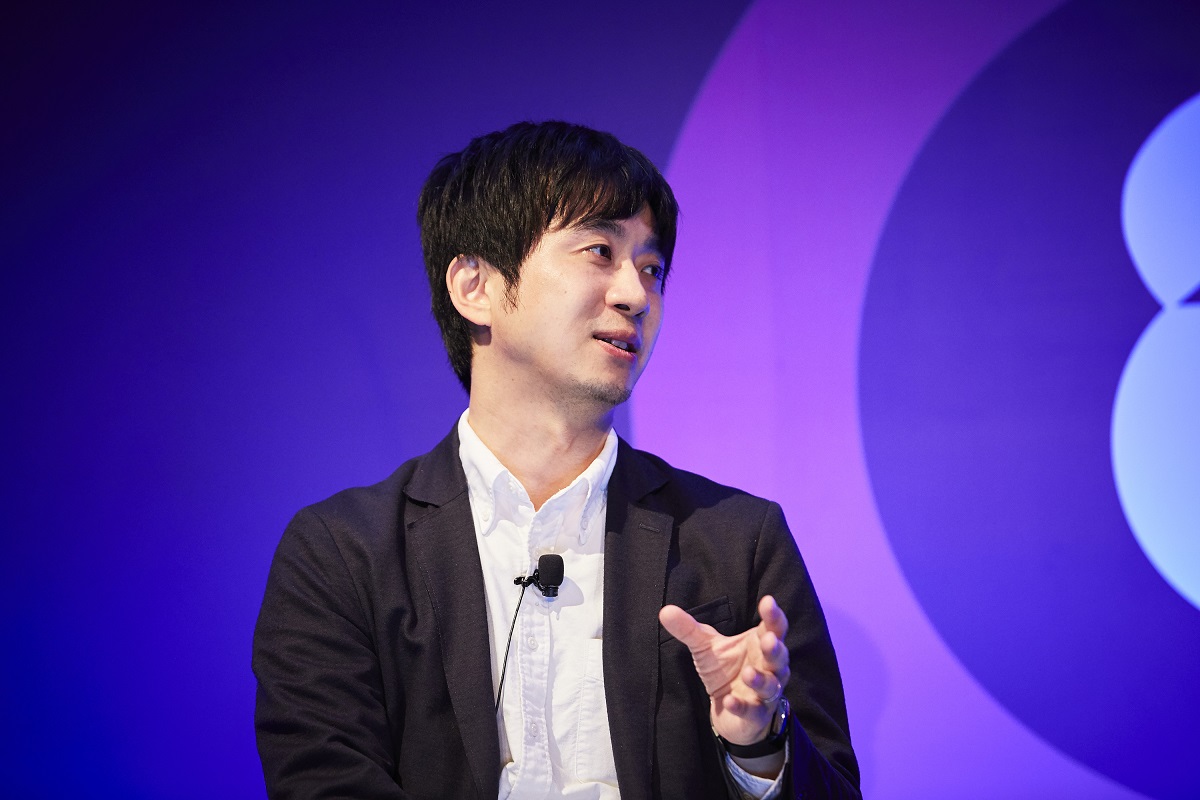
And from the perspective of today’s topic, what is ad creation, we are not creating deliverables and creative artifacts. Our job is to bring out the value of the brand, updating the attributes of its intrinsic qualities while accurately reflecting the climate of the times. I’d like you to start with a clear understanding of this point. Have a correct understanding of your work abilities and make them your own. Then move into those fields of activity that you are interested in and where you think the power of advertising is needed. With that series of processes in mind, I think that getting the basics right is important for you in the up-and-coming generation. And we are working on that, too. Let’s get it done together.
OKADA: Well that’s about all we have time for. We really look forward to having more and more discussions between our generation and yours. Thank you for your time today.
